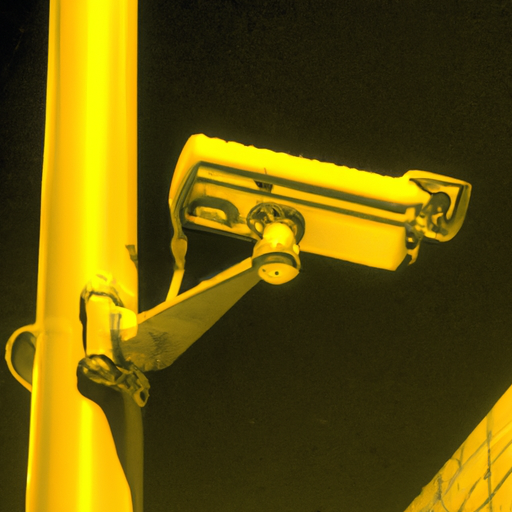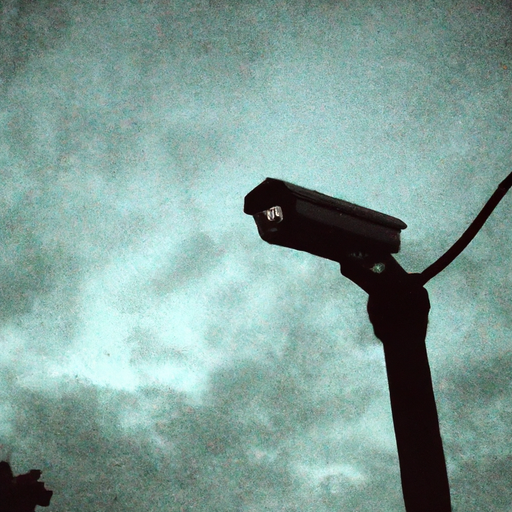
In this article, you’ll learn everything you need to know about infrared (IR) night vision in security cameras. We’ll discuss how it works, the benefits it offers, and its limitations. By the end, you’ll have a clear understanding of how infrared night vision can enhance the security of your property and keep you safe in low-light conditions.

Understanding Infrared (IR) Night Vision
Infrared (IR) night vision is a technology that allows security cameras to capture clear images and videos even in low light or complete darkness. This technology utilizes infrared light, which is invisible to the human eye but can be detected and utilized by cameras. By using infrared lighting, security cameras can effectively monitor and record activities in environments with insufficient visible light.
How does Infrared (IR) night vision work?
Infrared (IR) night vision works by illuminating the area of interest with infrared light. Security cameras equipped with IR night vision have built-in infrared LEDs (light-emitting diodes) that emit infrared light in the form of a beam or floodlight. When the camera detects low light conditions or darkness, it automatically switches to IR mode, activating the infrared LEDs.
The infrared light emitted by the LEDs reflects off objects within the camera’s field of view, and the camera’s sensor captures the reflected light. The sensor is specifically designed to be sensitive to infrared light, enabling it to convert the reflections into visible images or videos. This process allows security cameras to effectively monitor and record activities in dark environments.
The importance of Infrared (IR) night vision in security cameras
Infrared (IR) night vision is a crucial feature in security cameras as it enhances their effectiveness in various scenarios. By providing visibility in low light or darkness, IR night vision enables surveillance systems to operate around the clock, ensuring continuous monitoring and recording capabilities. Whether it is for home security, commercial surveillance, or law enforcement purposes, IR night vision greatly enhances the overall security and surveillance capabilities of cameras.
Types of Infrared (IR) Night Vision
There are different types of infrared (IR) night vision technologies used in security cameras. Each type operates differently and offers unique advantages in specific scenarios. Understanding these types will help in selecting the most suitable infrared night vision system for different security needs.
Passive Infrared (IR) night vision
Passive infrared (IR) night vision involves capturing the infrared emissions radiated by objects or subjects. This technology does not require any additional illumination sources and relies solely on the infrared radiation emitted by objects. Security cameras equipped with passive IR night vision sensors can detect and capture this emitted infrared radiation, creating visible images or videos.
Passive IR night vision is useful in scenarios where there is some ambient infrared radiation, such as starlight or moonlight. It allows cameras to capture clear images without alerting potential intruders to the presence of the camera.
Active Infrared (IR) night vision
Active infrared (IR) night vision employs additional illumination sources to enhance visibility in low light or darkness. Unlike passive IR night vision, active IR night vision cameras emit their own infrared light, which is then reflected off objects and captured by the camera’s sensor.
Active IR night vision is particularly effective in scenarios where there is minimal ambient infrared radiation. By actively illuminating the area of interest with infrared light, security cameras can capture clear images and videos, even in complete darkness.
Thermal Infrared (IR) night vision
Thermal infrared (IR) night vision operates based on the detection of heat emitted by objects and subjects. This technology creates images and videos based on the differences in thermal energy emitted by different objects. Security cameras equipped with thermal IR night vision sensors can detect and convert these temperature variations into visible images or videos.
Thermal IR night vision is highly effective in scenarios where traditional visible light is inadequate, such as heavy fog or smoke. It allows cameras to detect heat signatures and generate clear images, regardless of the lighting conditions.
Advantages of Infrared (IR) Night Vision
Infrared (IR) night vision offers various advantages that make it indispensable in security cameras. Understanding these advantages is essential in realizing the importance of IR night vision technology in surveillance systems.
Enhanced visibility in low light or darkness
The most significant advantage of IR night vision is the enhanced visibility it provides in low light or complete darkness. By utilizing infrared light, security cameras can capture clear images and videos, allowing for effective monitoring and recording, even when there is insufficient visible light available.
Wide coverage range
Infrared (IR) night vision technology provides cameras with a wide coverage range, allowing them to monitor larger areas. With the ability to detect infrared radiation or emit their own infrared light, cameras can effectively cover expansive spaces, ensuring comprehensive surveillance capabilities.
Covert surveillance capabilities
IR night vision technology enables security cameras to conduct covert surveillance operations. By utilizing passive IR night vision, cameras can capture images without relying on visible light, making them less noticeable. This covert capability is particularly advantageous in areas where the presence of cameras needs to be discreet.

Applications of Infrared (IR) Night Vision
Infrared (IR) night vision technology finds extensive applications in various security domains. Its effectiveness in low light or darkness makes it an invaluable tool for ensuring safety and security.
Home security systems
Infrared (IR) night vision technology is widely used in home security systems to enhance the overall surveillance capabilities. By providing visibility in low light conditions or darkness, IR night vision enables homeowners to monitor their properties and detect any potential threats or intrusions, ensuring peace of mind and safety for their families.
Commercial security systems
Commercial establishments, such as businesses, offices, and retail stores, rely heavily on IR night vision technology in their security systems. With the ability to monitor and record activities around the clock, IR night vision ensures comprehensive surveillance, preventing thefts, vandalism, and unauthorized access.
Law enforcement and military purposes
Infrared (IR) night vision is extensively used by law enforcement agencies and the military for various surveillance and operational purposes. From patrolling dark areas to conducting covert operations, IR night vision technology enables these organizations to gather critical intelligence and maintain security effectively.
Factors to Consider in Infrared (IR) Night Vision Cameras
When selecting infrared (IR) night vision cameras for security purposes, several factors need to be considered to ensure optimal performance and suitability for specific requirements.
Range of infrared illumination
The range of infrared illumination is an essential consideration when choosing IR night vision cameras. Different cameras offer varying ranges of infrared lighting, determining how far the camera can effectively capture clear images or videos in low light or darkness. It is important to select a camera with an adequate range to cover the desired surveillance area effectively.
Resolution and image quality
The resolution and image quality of IR night vision cameras play a critical role in capturing clear and detailed images or videos. High-resolution cameras with superior image quality ensure that the surveillance footage is in sufficient detail, facilitating accurate identification of people or objects.
Camera sensitivity to IR light
The sensitivity of the camera’s sensor to infrared light is crucial in ensuring optimal performance of IR night vision cameras. A highly sensitive sensor can efficiently capture and convert infrared reflections into visible images or videos, resulting in improved visibility and overall performance of the camera.
Limitations of Infrared (IR) Night Vision
While infrared (IR) night vision technology offers significant advantages, it also has certain limitations that need to be considered.
Limited color representation
Infrared (IR) night vision cameras primarily capture images in black and white or grayscale, limiting the representation of colors. This limitation is due to the reliance on infrared light, which does not produce the same color spectrum as visible light. While this does not affect the overall functionality of the cameras, it may hinder the ability to distinguish certain details in surveillance footage.
Glare and reflection issues
Infrared (IR) night vision cameras are susceptible to glare and reflection issues. When infrared light hits reflective surfaces, such as glass or metals, it can cause bright spots or flares, obscuring the surrounding areas. Proper placement and angling of the cameras can help mitigate these issues, but it is important to be aware of potential glare and reflection problems.
Distance limitations
The effectiveness of infrared (IR) night vision cameras decreases with distance. As the distance between the camera and the object increases, the reflected infrared light becomes weaker, resulting in reduced visibility and image quality. It is crucial to consider the desired surveillance range and select cameras with appropriate infrared illumination capabilities.
Comparing Infrared (IR) Night Vision with Other Technologies
Different technologies are available for enhancing visibility in low light or darkness. Comparing infrared (IR) night vision with other technologies helps in understanding their differences and determining the most suitable option for specific security requirements.
Infrared (IR) vs. Thermal imaging
Infrared (IR) night vision technology differs from thermal imaging in the way it captures and represents images. While IR night vision relies on the detection of infrared light and the reflection of this light off objects, thermal imaging detects and converts the differences in temperature emitted by objects into visible images or videos.
Each technology has its advantages and applications. Infrared (IR) night vision provides visibility in low light or darkness, whereas thermal imaging is effective in scenarios where temperature variations need to be detected, regardless of lighting conditions.
Infrared (IR) vs. Low-light cameras
Low-light cameras are designed to capture images and videos in very low levels of illumination, relying on available visible light. In contrast, infrared (IR) night vision cameras use infrared light to enhance visibility.
While low-light cameras can capture images in near-dark conditions, they may not perform as effectively as IR night vision cameras in complete darkness. IR night vision cameras provide consistent visibility even when there is no ambient visible light available, making them more suitable for surveillance operations in challenging lighting conditions.
Maintenance and Care for Infrared (IR) Night Vision Cameras
To ensure optimal performance and longevity of infrared (IR) night vision cameras, regular maintenance and care are essential.
Regular cleaning and lens maintenance
Regularly cleaning the camera lens is vital for achieving clear images and videos. Dust, dirt, and smudges can accumulate on the lens, affecting image quality. Cleaning the lens with a soft, lint-free cloth and a recommended cleaning solution can prevent these issues and maintain the camera’s performance.
Protective measures against harsh weather conditions
Infrared (IR) night vision cameras are often installed outdoor, exposed to various weather conditions. It is important to ensure that the cameras are adequately protected from extreme temperatures, humidity, and moisture. Weatherproof enclosures or protective covers can shield the cameras from these elements, minimizing the risk of damage and ensuring prolonged lifespan.
Future Developments in Infrared (IR) Night Vision Technology
As technology continues to evolve, exciting advancements in infrared (IR) night vision technology are expected. These advancements aim to further enhance the capabilities and performance of IR night vision cameras in the future.
Advancements in image processing algorithms
Future developments in IR night vision technology are likely to focus on improving image processing algorithms. These advancements will enable cameras to capture even clearer and more detailed images or videos, enhancing the overall surveillance capabilities.
Improved integration with other security technologies
Integration of infrared (IR) night vision technology with other security technologies is an area of ongoing development. Enhanced integration will allow for seamless interoperability between different security systems, providing a comprehensive and cohesive solution for surveillance and security needs.
Conclusion
Infrared (IR) night vision in security cameras plays a crucial role in enabling surveillance in low light or darkness. Understanding its workings, types, advantages, limitations, and applications is essential to make informed decisions for security purposes. As technology continues to evolve, we can expect exciting advancements in infrared (IR) night vision technology, further enhancing its effectiveness and expanding its applications in the field of security.